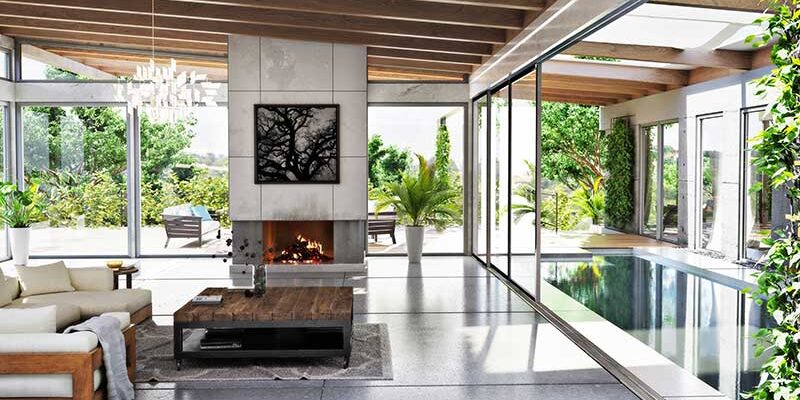In modern home design, the distinction between indoor and outdoor living spaces is becoming increasingly hazy. Architects and designers are taking advantage of the aesthetic and functional benefits of wide glass walls and sliding doors to create a seamless transition between a home’s interior and its natural surrounds. This not only improves a space’s visual attractiveness, but it also expands the functional living area, allowing you to take use of both indoor and outdoor luxuries.
The appeal of glass in modern architecture
Glass has long represented modernism and minimalism in architecture. Its ability to admit maximum natural light while providing uninterrupted views of the outside world makes it a popular choice among modern architects. Large glass walls and expansive sliding doors do more than simply look good; they bring the outdoors inside, allowing inhabitants to enjoy panoramic views of their gardens, pools, and landscapes without leaving their homes.
Design considerations for seamless indoor-outdoor spaces
Structural integrity
When designing with enormous expanses of glass, the structural stability of the building must come first. Architects frequently utilize reinforced glass and solid frames to enhance safety and longevity. The engineering underlying these constructions is intended to endure environmental stressors like wind, rain, and seismic activity.
Thermal Efficiency
One of the challenges of huge glass installations is ensuring energy efficiency. Modern options include the use of double-glazed or even triple-glazed glass panels to provide insulation against heat and cold. Some cutting-edge glass technologies include low-emissivity coatings and thermal breaks to limit heat transfer, ensuring that these stunning glass parts are both functional and environmentally benign.
Aesthetic Integration
Choosing the proper style of glass and framework is critical to ensuring that the glass pieces blend seamlessly with both the inside design and the exterior architecture. Frameless glass walls and minimalistic sliding doors are popular options because they allow a clear and uninterrupted view. Frames constructed of materials such as metal or natural wood can lend structural interest to the glass installation.
Indoor-Outdoor Living Spaces Offer Practical Benefits
Improved Quality of Life
The integration of indoor and outdoor spaces improves quality of life by combining nature with the home environment. It permits natural light to enter the interiors, improving mood and productivity. Furthermore, it facilitates the movement of social gatherings from the living room to the garden.
Increased Home Value
Prospective buyers frequently prefer homes with a seamless indoor-outdoor flow. This design component not only adds a wow factor, but it can also boost the property’s value, making it a sound investment in today’s real estate market.
Versatility in Use
Glass walls and sliding doors provide flexibility in how space is used and enjoyed. They can be entirely opened on nice days to expand the living space, or closed during bad weather to protect against the elements while maintaining the view.
The trend of blending indoor and outdoor spaces with enormous glass walls and sliding doors is more than simply an architectural design; it’s a lifestyle choice. It promotes openness, transparency, and a strong connection to nature, transforming everyday living spaces into breathtaking visual experiences and functional areas. For those wanting to rebuild or create a new house, following this design concept may help you get closer to establishing your ideal living environment, where every day feels like a seamless blend of interiors and outside.





